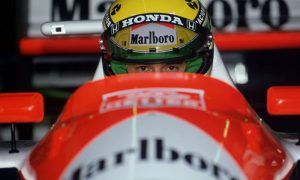When we first met, I was team manager at Larrousse, but there were only 7 of us when we started so I was also the tyre boy.
Well you had a responsible position as the tyre boy!
I did, yes. Team manager was nothing too strenuous. I also had to translate for you because Philippe Alliot (the driver) couldn’t really do the English then. That was ‘87, it was the tail end of your full-on career. That was an odd project, wasn’t it? You came as part of the package with the Lola chassis.
I don’t think I was ever supposed to be part of the team. I think the French had the idea that Lola were going to build the car, hand it over to them and they’d go off and race it. And we went and did an initial test at Donington and they realised there was a bit more to this than meets the eye and they thought they better keep me around for a little bit and it evolved to the point where I then ran the car in the engineering sense through the whole year.
The problem was, and you look around here and everybody’s going to think it’s a joke, but I was a one-man engineering department. Larrousse’s Formula 1 engineering department - I was it. You look at the hundreds of people that support these cars today and you think how did one person do that? But I treasure that era because it was your car and when you went onto the grid and looked up and down the grid, you were with your car and you took pride in where you were on the grid and stuff like that.
Did we have any form of telemetry in 87?
Nothing. No. All this discussion they’re having now I believe about what the team can say to the driver and stuff... Formula 1 is a sprint race. When the lights go out, it’s down to the driver. Up until then, it’s a team event. Once the lights go out, it should just be the driver. Leave him on his own, don’t talk to him, and see what he comes up with. It’s his couple of hours to go and show what he can do. I remember someone saying to me, the thing about Denny Hulme was he had terrific spatial awareness. He knew where everybody was on the track, where he was, what his chances were, what his options were and stuff like that. That’s what those drivers were like.
Do you appreciate the current technology or would you rather there was less?
How much technology do you need to put on a decent show? There’s so much technology here that people can’t understand. The man in the street can’t see it. They never get to see it. I finally yesterday got to see one of these cars with the bodywork off. It’s quite extraordinary. Designing a racing car of any sort really has always been a packaging exercise. You’ve got so many bits. You’ve got to stack them together in a heap that’s efficient for what you’re trying to do with it. You look at these things, and they’re just packing it all in tighter. It’s obvious that the big challenge now is managing the heat. That’s what it’s all about. You’ve got to manage the heat. You’ve got a battery pack that you’ve got to cool down. You’ve got an engine you’ve got to cool down. You’ve got generators and wiring and stuff and you’ve got to just manage the heat in an efficient way, which we never had to do. But it seems to me that’s what it’s all about now is managing the heat and still having an aerodynamically-efficient package overall.
Pick one driver that you worked with that really left an impression on you, apart from Mr Danner who’s here as your host.
I think Ronnie (Peterson). He was great. He was a lovely bloke. A lot of drivers and a lot of individual sportsmen are actually arseholes because that’s what you have to be to be a successful individual. A lot of individual sportsmen, you wouldn’t be bothered going for a beer with them and racing drivers can fall into that category. But Ronnie was just a lovely, lovely bloke but stunningly quick, absolutely stunningly quick. It was terrible to lose him. That finished me with motor racing as a fun thing to do. After that, it was business. I couldn’t work for two weeks after he died. I was in Brazil at the time and it had a profound effect on me, I have to say.
Apart from his skill at the wheel, was he a delight to work with as an engineer? Was he good on the feedback?
No.
He just drove the socks off it, did he?
I remember... Maybe we were at Zolder or somewhere and he’s saying “the car’s oversteering”. So I was changing the car and it wasn’t fixing the problem and I said, “Ronnie, just tell me exactly what’s going on” and he said, “When I get to the corner, it won’t go in like I want, so I throw it in and then when I get on the throttle, it oversteers.” I said: “Ronnie, you’ve got understeer not oversteer!”
Click here for more from Eric Silbermann's breakfasts in the paddock
F1i's Australian Grand Prix preview
2016 F1 season: Team-by-team preview









